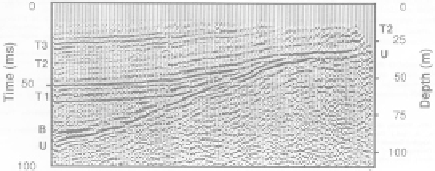Geology Reference
In-Depth Information
produce seismic sections of shallow subsurface geology
at reasonable cost. High-resolution reflection seismolo-
gy is particularly well suited to the investigation of
Quaternary sedimentary sequences (Fig. 4.56) and for
the detailed mapping of concealed bedrock surfaces of
irregular geometry (Fig. 4.64).The contrast between the
crustal (Fig. 4.63) and near-surface sections (Fig. 4.64)
neatly emphasizes the scalability of the seismic reflec-
tion method. In both these applications it is also
the geophysical method with the highest resolution,
both vertically and horizontally.
Fig. 4.64
A near-surface seismic reflection section showing
Mesozoic sediments (reflectors T1-T3 and B) with an angular
unconformity (U) against Lower Palaeozoic rocks. (From Ali &
Hill 1991.)
Problems
1.
A seismic wave is incident normally on a
reflector with a reflection coefficient
R
of
0.01. What proportion of the incident energy is
transmitted?
2.
What is the root-mean-square velocity in
reflection surveying, and how is it related to
interval velocity and to stacking velocity?
3.
A zero-offset reflection event at 1.000 s has
a normal moveout (NMO) of 0.005 s at 200 m
offset. What is the stacking velocity?
4.
(a) Calculate the approximate dimensions of
the Fresnel zone in the following two cases:
(i) Reflection profiling is used to investigate
lower crustal structure at a depth of about 30 km.
The dominant frequency of the reflected pulse is
found to be 10 Hz. Using a typical average
crustal velocity of 6.5 km s
-
1
.
(ii) A high-resolution reflection survey is used to
map rockhead beneath a Quaternary sediment
cover about 100 m thick using a high-frequency
source. The dominant frequency of the reflected
pulse is found to be 150 Hz. Use a sediment
velocity of 2 km s
-
1
.
(b) Discuss the importance of the above Fresnel
zone dimensions as indications of the inherent
limits on horizontal resolution achievable in
different types of reflection survey.
(c) Use the frequency and velocity information
to calculate the vertical resolution of the two
surveys above and again discuss the general
importance of the results obtained to the verti-
cal resolution that is achievable in reflection
seismics.
5.
In the initial stages of a seismic reflection sur-
vey, a noise test indicates a direct wave with a ve-
locity of 3.00 km s
-
1
and a dominant frequency
of 100 Hz, and ground roll with a velocity of
1.80 km s
-
1
and a dominant frequency of 30 Hz.
What is the optimum spacing of individual geo-
phones in five-element linear arrays in order to
suppress these horizontally-travelling phases?
6.
In CDP stacking, the method of applying a
NMO correction to individual seismic traces cre-
ates distortion in seismic pulses recorded at large
offset that can degrade the stacking process.
Why?
7.
Along a two-dimensional marine survey line
involving a 48-channel streamer with a hy-
drophone array interval of 10 m, shots are fired
every 40 m.
(a) What is the fold of CMP cover?
(b) If the cover is to be increased to 24-fold, what
must the new shot interval be?
8.
In single-channel seismic profiling, what is
the optimum depth for towing an air gun source
with a dominant frequency of 100 Hz such that
the reflected ray from the sea surface will inter-
fere constructively with the downgoing primary
pulse? (The compressional wave velocity in sea
water is 1.505 km s
-
1
.)
9.
What is the significance of the curved bound-
ary lines to the typical ground roll sector of the
f
-
k
plot illustrated in Fig. 4.25, and how may it be
explained?
10.
How may three-dimensional seismic survey
data be used to study velocity anisotropy?)


